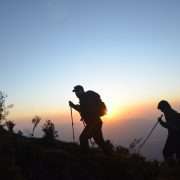
Facts about mount Kenya and the Routes
- Mount Kenya is the highest mountain in Kenya and the second-highest in Africa, with an elevation of 5,199 meters (17,057 feet).
- The mountain is a stratovolcano that formed millions of years ago due to volcanic activity.
- Mount Kenya is located in central Kenya, near the equator, and is approximately 150 kilometers (93 miles) northeast of Nairobi, the country’s capital.
- The mountain is part of the Mount Kenya National Park, which covers an area of 715 square kilometers (276 square miles) and was designated as a UNESCO World Heritage site in 1997.
- Mount Kenya has several peaks, with Batian being the highest at 5,199 meters (17,057 feet) and Nelion being the second-highest at 5,188 meters (17,021 feet). Point Lenana, the third-highest peak, is commonly climbed by hikers and is at an elevation of 4,985 meters (16,355 feet).
- The mountain is surrounded by a diverse range of ecosystems, including afro-alpine moorland, montane forest, and bamboo belts, which support a variety of plant and animal species.
- Mount Kenya is known for its unique equatorial snow caps, which are remnants of a large ice sheet that covered the mountain during the last ice age. However, these ice caps have been shrinking rapidly in recent decades due to climate change.
- The mountain holds significant cultural and spiritual importance for various ethnic groups in Kenya, including the Kikuyu and Embu people, who believe that God, Ngai, resides on the peak of Mount Kenya.
- Mount Kenya offers various outdoor activities, such as hiking, mountaineering, rock climbing, and wildlife viewing. It attracts both experienced climbers and tourists seeking adventure.
- The mountain is home to a wide range of wildlife, including elephants, buffalo, hyenas, monkeys, and numerous bird species. The surrounding national park provides protection for these animals and is an important conservation area in Kenya.
Mount Kenya Routes
There are several routes to climb Mount Kenya, each offering unique experiences and varying levels of difficulty. Here are the main routes:
- Naro Moru Route: The Naro Moru Route is the most popular and fastest route to the summit of Mount Kenya. It starts at Naro Moru town and ascends through the rainforest, then continues through heath and moorland zones. The route involves some steep sections, including the Vertical Bog and the notorious “Vertical Mile.” It typically takes about 4-5 days to complete.
- Sirimon Route: The Sirimon Route is the most scenic and gentle route on Mount Kenya. It starts at the Sirimon Gate on the northwest side of the mountain and passes through bamboo forests, moorlands, and the picturesque Mackinder Valley. The ascent is more gradual compared to other routes, giving climbers more time to acclimatize. The trek usually takes 4-6 days.
- Chogoria Route: The Chogoria Route is considered the most beautiful but also the most challenging route to the summit of Mount Kenya. It begins at the Chogoria Gate on the eastern side of the mountain and involves a long and demanding hike through lush valleys, highland forests, and alpine moorlands. The route offers breathtaking views of the Gorges Valley and the Temple. Climbers typically take 5-7 days to complete the trek.
- Burguret Route: The Burguret Route is one of the lesser-known routes up Mount Kenya. It starts at the Burguret Gate on the western side of the mountain and follows a less-traveled path through dense montane forests, bamboo zones, and high moorlands. The route offers excellent opportunities for wildlife viewing. This route is more remote and less crowded than the others, making it a great choice for those seeking a quieter experience. The trek usually takes 5-6 days.
- Timau Route: The Timau Route approaches from the North of the mountain following a meandering route through the gentler northern slopes until they steepen at around 4200m. From here it drops abruptly into and across the Hinde Valley and the Nithi North river before climbing up to meet the Chogoria Route at Simba Col. The route lies in a major rain shadow. Because of this there is a very little forest on this side of the mountain. However, the low rainfall zone it generally makes for a drier trek. The slope is gentle and because the peaks on Mount Kenya line up east to west the views from the north give you the impression you are trekking into a whole mountain range.
It’s important to note that climbing Mount Kenya is a challenging endeavor that requires proper preparation, including physical fitness, acclimatization, and the use of experienced guides. It’s advisable to seek the assistance of licensed tour operators or mountaineering agencies who can provide the necessary support and equipment for a safe and successful climb.
Recent Posts
August 11, 2025kiprotich dominic0 Comments
Mount Kenya Charity walks
August 11, 2025Willy Mutai0 Comments
Mount Kenya Day Hike
June 6, 2025Willy Mutai0 Comments
Mount Kenya Challenge Program
All Categories
Tags
Adventure
africaoutdoors
arusha
batian
batian.nelion
chogoria
day hike
elgon
Hiking
hiking adventures
kamweti
kili
Kilimanjaro
kitale
lemosho
lenana
likii north
machame
marangu
marich
moshi
mountains
mount Kenya
mount Kilimanjaro Adventure
mtelo
mtmeru
mt mtelo
nairobi
namanga
nanyuki
naromoru
nelion
oldmoses
Outdoor
pokot
rongai
routes
sekerr
shipton
sirimon
tours
travel
ubwe
uhuru peak
west pokot

Wildlife
Thailand




